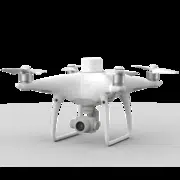Loading ...
Loading ...
Loading ...

32
©
2020 DJI All Rights Reserved.
Phantom 4 RTK User Manual
* This mode will be supported later.
Assisted Braking from Obstacle Sensing
Powered by the Obstacle Sensing, the aircraft will now be able to actively brake when obstacles are
detected around the aircraft. Note that Obstacle Sensing function works best when lighting is adequate
and the obstacle is clearly marked or textured. The aircraft must y at no more than 31mph (50kph) to allow
sucient braking distance.
The 3D Infrared Sensing System is only active in Beginner mode* and Tripod mode*. Fly with
caution.
The performance of your Vision System and Infrared Sensing System are aected by the surface being
own over. Ultrasonic sensors may not be able to accurately measure distances when operating above
sound-absorbing materials and the camera may not function correctly in suboptimal environments.
The aircraft will switch from P-mode to A-mode automatically if neither vision sensors nor ultrasonic
sensors and Infrared Sensing System are available. Operate the aircraft with great caution in the following
situations:
a) Flying over monochrome surfaces (e.g. pure black, pure white, pure red, pure green).
b) Flying over a highly reective surfaces.
c) Flying at high speeds of over 31mph (50kph) at 2 meters or over 11mph (18kph) at 1 meter.
d) Flying over water or transparent surfaces.
e) Flying over moving surfaces or objects.
f) Flying in an area where the lighting changes frequently or drastically.
g) Flying over extremely dark (lux < 10) or bright (lux > 100,000) surfaces.
h) Flying over surfaces that can absorb sound waves (e.g. thick carpet).
i) Flying over surfaces without clear patterns or texture.
j) Flying over surfaces with identical repeating patterns or textures (e.g. tiling).
k) Flying over inclined surfaces that will deect sound waves away from the aircraft.
l) Flying over obstacles with too small eective infrared reective surface.
m) DO NOT position the sides of two aircraft toward each other to avoid interference between
the 3D infrared modules.
n) DO NOT cover the protective glass of the infrared module. Keep it clean and undamaged.
o) Flying at high speed at low altitude (under 0.5 m).
Keep sensors clean at all times. Dirt or other debris may adversely aect their eectiveness.
Vision Positioning is only eective when the aircraft is at altitudes of 0.3 to 10 meters.
The Vision Positioning may not function properly when the aircraft is ying over water.
The Vision System may not be able to recognize pattern on the ground in low light conditions (less
than 100 lux).
Do not use other ultrasonic devices with frequency of 40 kHz when Vision System is in operation.
Loading ...
Loading ...
Loading ...
